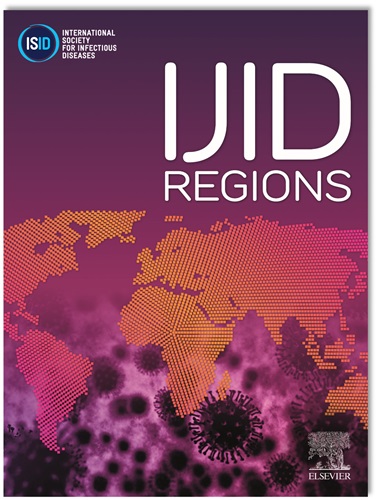First reports of urogenital schistosomiasis in the Ndikiniméki health district, Centre-Cameroon
IF 4.8
2区 医学
Q1 INFECTIOUS DISEASES
引用次数: 0
Abstract
Introduction
Schistosomiasis is still a public health problem in Sub-Saharan Africa, particularly in Cameroon. In this context, a cross-sectional study was carried out from June 2023 to July 2023 in the Ndikiniméki subdivision with the aim of knowing the status of this locality in relation to Schistosoma haematobium infection.
Methods
Parasitological analysis of S. haematobium eggs was carried out on urine samples using the sedimentation technique.
Results
A total of 402 urine samples were collected from households. The age range of participants was 1 to 96 years, with the most signified age group being 1 to 9 years. Women were the most represented, with a proportion of 56.47%. Of the 402 people examined, 18 (4.45%) were affected, with an average intensity of 54.43±85.30 eggs/10ml urine. Women were the most affected, with a prevalence and average parasite intensity of 3.73% and 53.10±131.27 eggs/10ml of urine. The most affected age group was 10 to 19-year-olds, with a prevalence and intensity of 4.60% and 49.49±67.00 eggs per 10 ml of urine, respectively. Of those infected, 72.22% were lightly infected and 27.28% were heavily infected.
Conclusions
This study indicates that this locality is a risk area for urinary schistosomiasis despite its low prevalence.
喀麦隆中部ndikinimsamuki卫生区首次报告泌尿生殖系统血吸虫病
血吸虫病在撒哈拉以南非洲仍然是一个公共卫生问题,特别是在喀麦隆。在这方面,从2023年6月至2023年7月在ndikinimsamuki分区进行了一项横断面研究,目的是了解该地区与血血吸虫感染有关的状况。方法采用沉淀法对尿样进行血氧梭菌卵的寄生虫学分析。结果共收集住户尿液样本402份。参与者的年龄范围为1 - 96岁,最显著的年龄组为1 - 9岁。女性的比例最高,为56.47%。402人中有18人(4.45%)受到影响,平均强度为54.43±85.30个鸡蛋/10ml尿。女性感染率最高,平均寄生虫密度为3.73%,53.10±131.27个/10ml尿。发病年龄以10 ~ 19岁人群居多,发生率和强度分别为4.60%和49.49±67.00个/ 10 ml尿。轻度感染占72.22%,重度感染占27.28%。结论该地区尿路血吸虫病发病率虽低,但仍是尿路血吸虫病的高危地区。
本文章由计算机程序翻译,如有差异,请以英文原文为准。
求助全文
约1分钟内获得全文
求助全文
来源期刊
CiteScore
18.90
自引率
2.40%
发文量
1020
审稿时长
30 days
期刊介绍:
International Journal of Infectious Diseases (IJID)
Publisher: International Society for Infectious Diseases
Publication Frequency: Monthly
Type: Peer-reviewed, Open Access
Scope:
Publishes original clinical and laboratory-based research.
Reports clinical trials, reviews, and some case reports.
Focuses on epidemiology, clinical diagnosis, treatment, and control of infectious diseases.
Emphasizes diseases common in under-resourced countries.

 求助内容:
求助内容: 应助结果提醒方式:
应助结果提醒方式:


